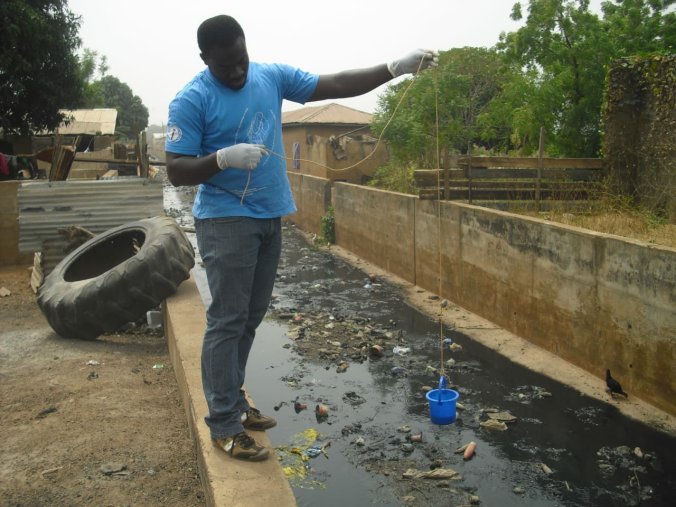
Photo credit: Courage Kosi Setsoafia Saba, University for Development Studies, Ghana.
Researchers have found that sewage surveillance can help in understanding the circulation of novel coronavirus (SARS-CoV-2) in the community. Sewage surveillance becomes particularly useful as a large percentage of infected population is either asymptomatic or show only mild symptoms, and may not be tested.
Sampling sewage for viral particles is a time-tested method of environment surveillance and is routinely resorted for understanding circulation of several viruses — wild and vaccine-derived polio, rota virus, Hepatitis E and typhoid — in the community. Now, researchers in France have found that sewage surveillance can help in understanding the circulation of novel coronavirus (SARS-CoV-2) in the human population.
People infected with the virus have been found to shed the virus in their stools. And by study sewage samples, it is possible to know the viral load in the community through modelling once data on how many viral particles are shed by individuals and how the viral particles get diluted in sewage are available.
In the case of novel coronavirus, sewage surveillance becomes particularly useful as a large percentage of infected population is either asymptomatic or show only mild symptoms. Hence, there is a greatly likelihood that circulation of the virus in the community will be detected quite late, if at all. The circulation is likely to continue undetected till such time community testing is ramped up so that many get tested, or till such time people become severely ill requiring hospitalisation.
While a few other researchers have found coronavirus in sewage samples, the study posted on medRxiv preprint server, which is yet to be peer-reviewed, has shown that the environmental surveillance is able to pick up a spike in virus concentration in sewage much before cases show up or overload and strain the healthcare system. The other benefit is that sewage surveillance can be carried out independent of testing in humans and will be able to pick up early signs even when people in the community do not show symptoms. The ability of sewage surveillance to decipher community spread even when people are asymptomatic is akin to antibody testing.
The study carried out in greater Paris for a month (March 5 to April 7) and samples were picked twice a week from 23 raw and eight treated wastewater sites. The study found that the rise and fall in coronavirus concentrations closely matched the COVID-19 outbreak in the region. Most interestingly, the team led by Dr. Moulin L from Sorbonne Universite, CNRS, Paris found high concentration of viral RNA about a week before multiple deaths were recorded in Paris on March 10.
And the virus concentration in wastewater had the same trend as cases and deaths. The concentration of virus in the wastewater samples increased a few days ahead of an increase in cases and deaths in the city. “We have a very clear curve that precedes the curve in numbers of clinical cases, and now with confinement, we see a flattening of that curve,” Laurent Moulin, a study co-author and a microbiologist at Eau de Paris told the journal Science.
Surveillance of virus in sewage is not only easy but also good to track and monitor the spread of the virus in the community, says a senior researcher based in India who has carried out sewage surveillance for a few different viruses.
“Environmental surveillance is the key to know and understand community transmission. But one should be clear when to carry out sewage surveillance — when cases have come down once the outbreak has been controlled or before cases show up so as to predict an outbreak,” she says. “In the case of novel coronavirus, sewage surveillance is a good way to detect asymptomatic cases and those who exhibit mild symptoms, who might otherwise not be tested.”
According to the scientist, there are two ways to take sewage samples — pick up samples at several places to monitor the presence of the virus in a community living in upstream catchment area and/or terminal sites where the sewage of the city/town is treated or let out into water bodies.
That the presence of the virus in wastewater treatment closely correlated with cases in greater Paris, reflects how useful this method is in tracking community spread. Higher concentrations of the virus in the wastewater did correspond to higher number of infected people in the region.
“Viral particles in sewage samples is a collection of virus shed by many people in the community and is akin to pooled testing,” the scientist said. “But sewage sampling is not a replacement to testing for infection in people but is only a supplement.”
The best time and place to carry out sewage sampling in India for coronavirus is when testing of people has been sorted and in places where no cases have been reported, she says.